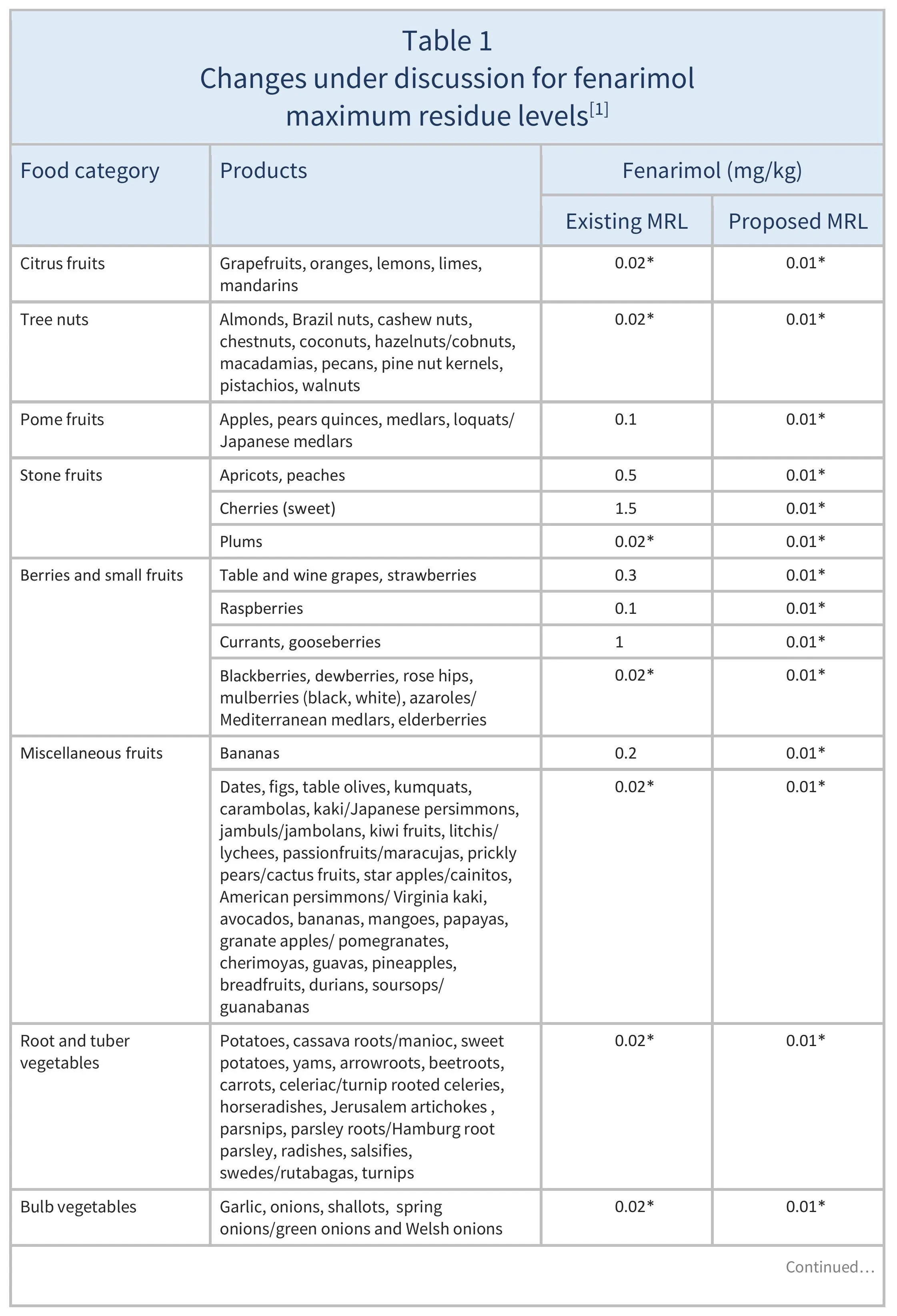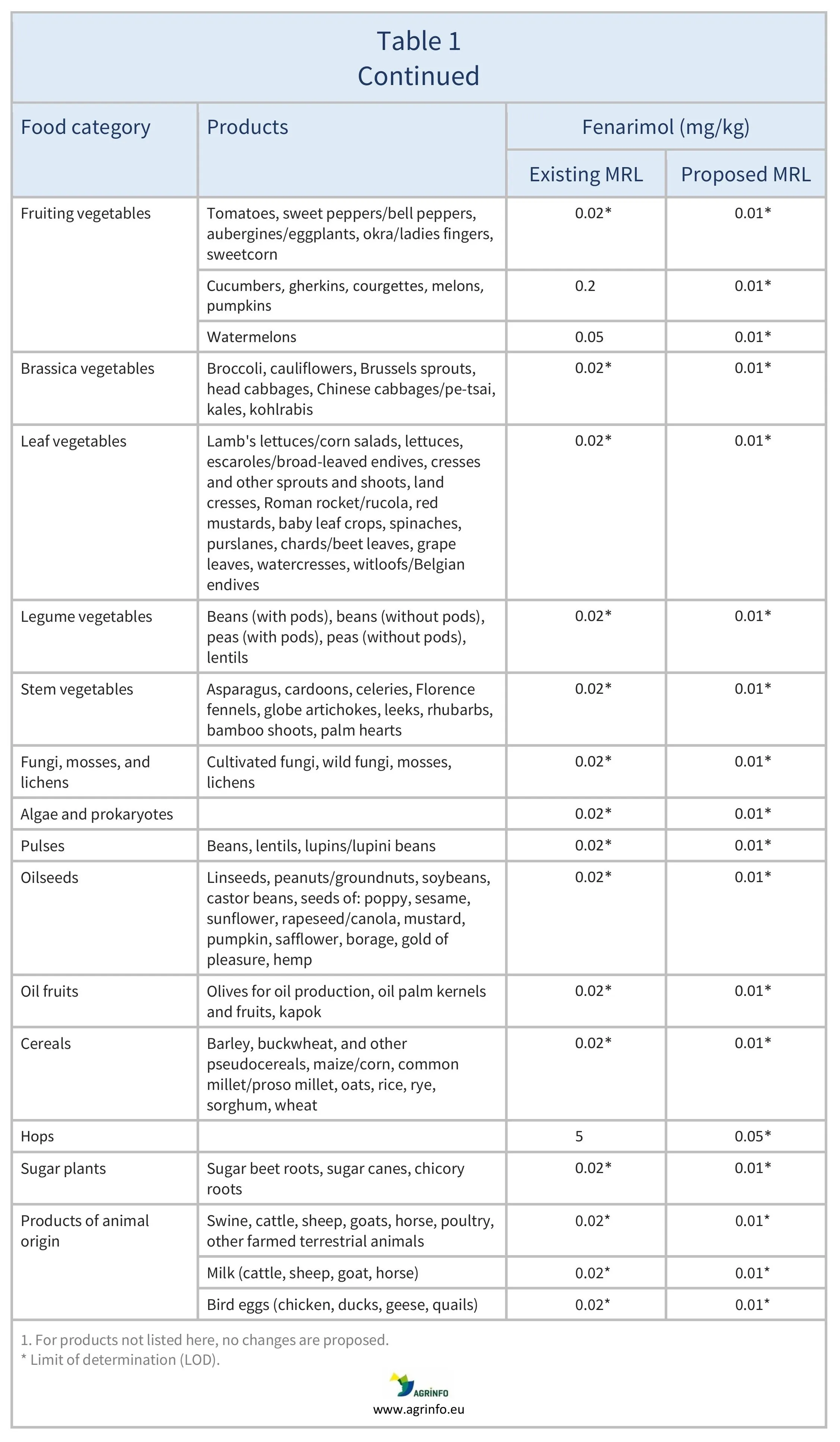Maximum residue levels for fenarimol
- Food safety
- Pesticide MRLs
Summary
The European Union (EU) is discussing reducing the maximum residue levels (MRLs) for fenarimol to the limit of determination (LOD) of 0.01 mg/kg on apricots, cherries, peaches, grapes, strawberries, raspberries, currants, gooseberries, bananas, cucumbers, gherkins, courgettes, melons, watermelons, and hops. (The LOD is the lowest level that can be detected using the most modern and reliable analytical methods.) A reduction in current LODs on certain other products is also proposed.
EU discusses reduction of fenarimol MRLs, with particular impacts on some fruits and vegetables, and hops
Draft Commission Regulation amending Annexes II, III and V to Regulation (EC) No 396/2005 of the European Parliament and of the Council as regards maximum residue levels for azocyclotin, chlorfenapyr, cyhexatin, diazinon, dicofol, endosulfan, fenarimol, fenpropathrin and profenofos in or on certain products
Draft Annex
Update
The European Union (EU) is discussing reducing the maximum residue levels (MRLs) for fenarimol to the limit of determination (LOD) of 0.01 mg/kg on apricots, cherries, peaches, grapes, strawberries, raspberries, currants, gooseberries, bananas, cucumbers, gherkins, courgettes, melons, watermelons, and hops. (The LOD is the lowest level that can be detected using the most modern and reliable analytical methods.) A reduction in current LODs on certain other products is also proposed.
Impacted Products
Grapefruits, oranges, lemons, limes, mandarins, almonds, Brazil nuts, cashew nuts, chestnuts, coconuts, hazelnuts/cobnuts, macadamias, pecans, pine nut kernels, pistachios, walnuts, apples, pears, quinces, medlars, loquats/Japanese medlars, apricots, peaches, cherries (sweet), plums, table and wine grapes, strawberries, raspberries, currants, gooseberries, blackberries, dewberries, rose hips, mulberries (black and white), azaroles/Mediterranean medlars, elderberries, bananas, dates, figs, table olives, kumquats, carambolas, kaki/Japanese persimmons, jambuls/jambolans, Kiwi fruits, litchis/lychees, passionfruits/maracujas, prickly pears/cactus fruits, star apples/cainitos, American persimmons/Virginia kaki, avocados, bananas, mangoes, papayas, granate apples/pomegranates, cherimoyas, guavas, pineapples, breadfruits, durians, soursops/guanabanas, potatoes, cassava roots/manioc, sweet potatoes, yams, arrowroots, beetroots, carrots, celeriac/turnip rooted celeries, horseradishes, Jerusalem artichokes, parsnips, parsley roots/Hamburg root parsley, radishes, salsifies, swedes/rutabagas, turnips, garlic, onions, shallots, spring onions/green onions, Welsh onions, tomatoes, sweet peppers/bell peppers, aubergine/eggplants, okra/ladies’ fingers, sweetcorn, cucumbers, gherkins, courgettes, melons, pumpkins, watermelons, broccoli, cauliflowers, Brussels sprouts, head cabbages, Chinese cabbages/pe-tsai, kales, kohlrabies, lamb’s lettuces/corn salads, lettuces, escaroles/broad-leaved endives, cresses and other sprouts and shoots, land cresses, Roman rocket/rucola, red mustards, baby leaf crops, spinaches, purslanes, chards/beet leaves, grape leaves, watercresses, witloofs/Belgian endives, beans (with and without pods), peas (with and without pods), lentils, asparagus, cardoons, celeries, Florence fennels, globe artichokes, leeks, rhubarbs, bamboo shoots, palm hearts, cultivated fungi, wild fungi, mosses and lichens, algae and prokaryotes, lupins/lupini beans, linseeds, peanuts/groundnuts, poppy seeds, sesame seeds, sunflower seeds, rapeseeds/canola seeds, soyabeans, mustard seeds, cotton seeds, pumpkin seeds, safflower seeds, borage seeds, gold of pleasure seeds, hemp seeds, castor beans, olives for oil production, oil palm kernels, oil palm fruits, kapok, barley, buckwheat and other pseudocereals, maize/corn, common millet/proso millet, oats, rice, rye, sorghum, wheat, sugar beet roots, sugar canes, chicory roots, hops, animal products (swine, cattle, sheep, goat, equine, poultry, other farmed terrestrial animals), milk (cattle, sheep, goat, horse), bird eggs (chicken, duck, geese, quail)
What is changing?
The EU is discussing the reduction of MRLs for fenarimol as summarised in Table 1.
Why?
The MRLs for fenarimol that have been in place since the adoption of Regulation 396/2005 have never been reviewed. Following a series of evaluations and a stakeholder consultation (see EFSA invites submission of data to support review of certain MRLs), the European Food Safety Authority was not able to conclude a risk assessment due to inadequate toxicological data (EFSA 2023).
Timeline
This Regulation is still under discussion. It is expected that new MRLs will apply from late 2026 or early 2027.
Recommended Actions
Suppliers to the EU market of apricots, cherries, peaches, grapes, strawberries, raspberries, currants, gooseberries, bananas, cucumbers, gherkins, courgettes, melons, watermelons, and hops should review their existing use of fenarimol and start to seek alternative (chemical or non-chemical) solutions in anticipation of the MRL reductions.
Background
MRLs are set in accordance with the rules set out in Regulation 396/2005. For information on current MRLs for other substances, please consult the EU Pesticide Residues database.
For further information on the EU’s process and principles for setting MRLs, see Regulation of pesticide residues in the EU - Questions and Answers.
Resources
EFSA (2023) Targeted review of maximum residue levels (MRLs) for fenarimol. EFSA Journal, 21(7): 8113.
Sources
Draft Commission Regulation as regards maximum residue levels for azocyclotin, chlorfenapyr, cyhexatin, diazinon, dicofol, endosulfan, fenarimol, fenpropathrin and profenofos in or on certain products
Draft Annex
Tables & Figures
Disclaimer: Under no circumstances shall COLEAD be liable for any loss, damage, liability or expense incurred or suffered that is claimed to have resulted from the use of information available on this website or any link to external sites. The use of the website is at the user’s sole risk and responsibility. This information platform was created and maintained with the financial support of the European Union. Its contents do not, however, reflect the views of the European Union.
EU discusses reduction of fenarimol MRLs, with particular impacts on some fruits and vegetables, and hops
Draft Commission Regulation as regards maximum residue levels for azocyclotin, chlorfenapyr, cyhexatin, diazinon, dicofol, endosulfan, fenarimol, fenpropathrin and profenofos in or on certain products
Draft Annex
What is changing and why?
The European Union (EU) is discussing the reduction of fenarimol maximum residue levels (MRLs) on certain fruits and vegetables to 0.01 mg/kg. There will be impacts on apricots, cherries, peaches, grapes, strawberries, raspberries, currants, gooseberries, bananas, cucumbers, gherkins, courgettes, melons, watermelons, and hops (see Table 1). This is because the European Food Safety Authority was unable to complete a risk assessment of this pesticide.
Actions
Suppliers to the EU market of apricots, cherries, peaches, grapes, strawberries, raspberries, currants, gooseberries, bananas, cucumbers, gherkins, courgettes, melons, watermelons, and hops should review their existing use of fenarimol and start to identify alternative pesticides.
Timeline
This Regulation is still under discussion. It is expected that new MRLs will apply from late 2026 or early 2027.
Tables & Figures
Disclaimer: Under no circumstances shall COLEAD be liable for any loss, damage, liability or expense incurred or suffered that is claimed to have resulted from the use of information available on this website or any link to external sites. The use of the website is at the user’s sole risk and responsibility. This information platform was created and maintained with the financial support of the European Union. Its contents do not, however, reflect the views of the European Union.


